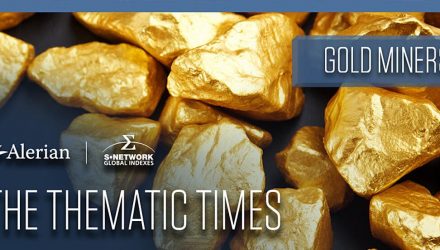Investors who are bullish on gold may be interested in the gold miner sector, given that gold miner performance typically magnifies the directional movement of gold prices. In other words—when gold prices increase, gold miners often perform even better; however, when gold prices fall, gold miner performance may fall even harder.
In 2020, gold prices increased over 25% as market uncertainty caused many investors to move to safer assets. Many gold bulls expected the rally to continue into 2021 as inflation fears persisted. Although gold prices were down close to 6% YTD as of December 10, 2021, daily gold prices averaged $1,779 per ounce throughout the year—flat from the 2020 average. Prices were relatively stable for most of the year, fluctuating between ~$1,700 to ~$1,900 per ounce. However, gold miner total return performance was down significantly more—off 18% YTD as of December 10 as measured by the S-Network Micro Sectors Gold Miners Index (MINERS). Investors may have been concerned that gold miner returns were underperforming gold prices more severely than expected, especially given the relative stability of gold prices in 2H21. Investors and advisors need to realize that gold miner performance can diverge from gold prices due to several other factors.
First of all, gold miners typically report a figure called “All-in Sustaining Costs” or AISC, which includes all costs associated with gold mining. AISC has increased each quarter since 4Q20 due primarily to inflationary expenses like labor, materials, and freight transportation. In 3Q21, industry AISC reached the highest level since 2013. Since AISC has been increasing faster than gold prices, many companies within the industry experienced margin pressure, which has affected earnings and contributed to negative stock price sentiment. But despite recent margin contraction, margins have been stabilizing at a relatively high level compared to previous quarters, as seen in the chart below.

In addition to cost pressures, gold mining companies are also affected by other company-specific risks independent of commodity price movements. For example, each gold mining company has a unique operating strategy, market position, and executive management team. Gold mining companies are also affected by their ability to find and efficiently mine gold reserves and are subject to geopolitical, environmental, and other legal risk factors, given the global nature of the mining business. Many of these issues were in focus during the pandemic as gold mining companies had to deal with inconsistent and unexpected disruptions across different geographies.
Bottom Line:
While it is true that gold miner revenues are leveraged to gold prices, other factors can cause earnings and stock prices to diverge in unexpected ways. Investors who were disappointed with gold miner performance in 2021 should consider that recent pressures could subside in the future (e.g., cost pressures and COVID-related operational issues). Additionally, when looking at long-term margin trends and the production outlook, the sector still has positive fundamentals. Investors who are bullish on gold and willing to assume greater risk for a greater reward may want to look at gold miners.
The S-Network MicroSectors Gold Miners Index (MINERS) is the underlying index for the MicroSectors Gold Miners 3x Leveraged ETN (GDXU) and MicroSectors Gold Miners -3x Inverse Leveraged ETN (GDXD).

For more market trends, visit ETF Trends.








